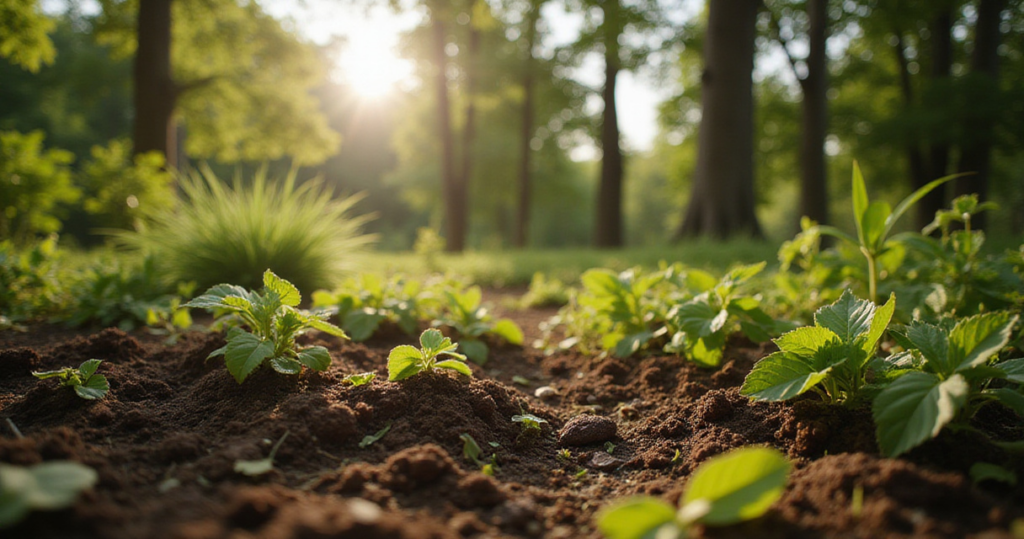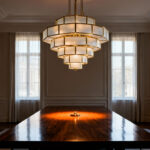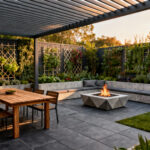Can we talk about why everyone gets their backyard wrong? People treat it like a chore or a checklist they saw on a home improvement show. They think a great backyard comes from a catalog: buy the matching patio set, install the trendy fire pit, plant the same five shrubs as your neighbor. It’s an exercise in acquisition, not creation.
Here’s what they’re not telling you: I’ve spent my career curating gallery spaces and placing priceless artwork. And what I’ve learned is that creating a breathtaking space—whether it’s a room in the MoMA or the 30 feet behind your house—has nothing to do with following trends. It’s about composition, light, and story. Your backyard isn’t just a plot of land; it’s the largest, most dynamic canvas you will ever own. These 23 curated pieces of advice aren’t just a list; they’re a new way of seeing. They’ll show you how to stop decorating and start curating.
Laying the Groundwork: Strategic Planning & Assessment (Part 1)
Before an artist touches a canvas, they understand its texture and size. Before a curator hangs a show, they walk the gallery a hundred times, feeling its light and its shadows. This is that stage. This isn’t the boring part; it’s the most creative part. It’s where you define the story you want to tell. It’s where you listen to the space and let it tell you what it wants to be. Don’t rush this—this is where the masterpiece begins.
1. Assess Your Yard’s Unique Conditions for Optimal Plant Health
Think of your yard’s soil, sun, and water as the fundamental architecture of your gallery. You wouldn’t hang a fragile watercolor in direct, unforgiving sunlight, would you? The same principle applies here. Understanding these conditions isn’t about tedious science; it’s about respecting your materials. Knowing you have acidic soil in a shady corner is like knowing you have a beautifully lit wall perfect for a dramatic sculpture. Working with these elements, not against them, is the first rule of artful design. It leads to installations—plants, in this case—that don’t just survive, but make a statement.
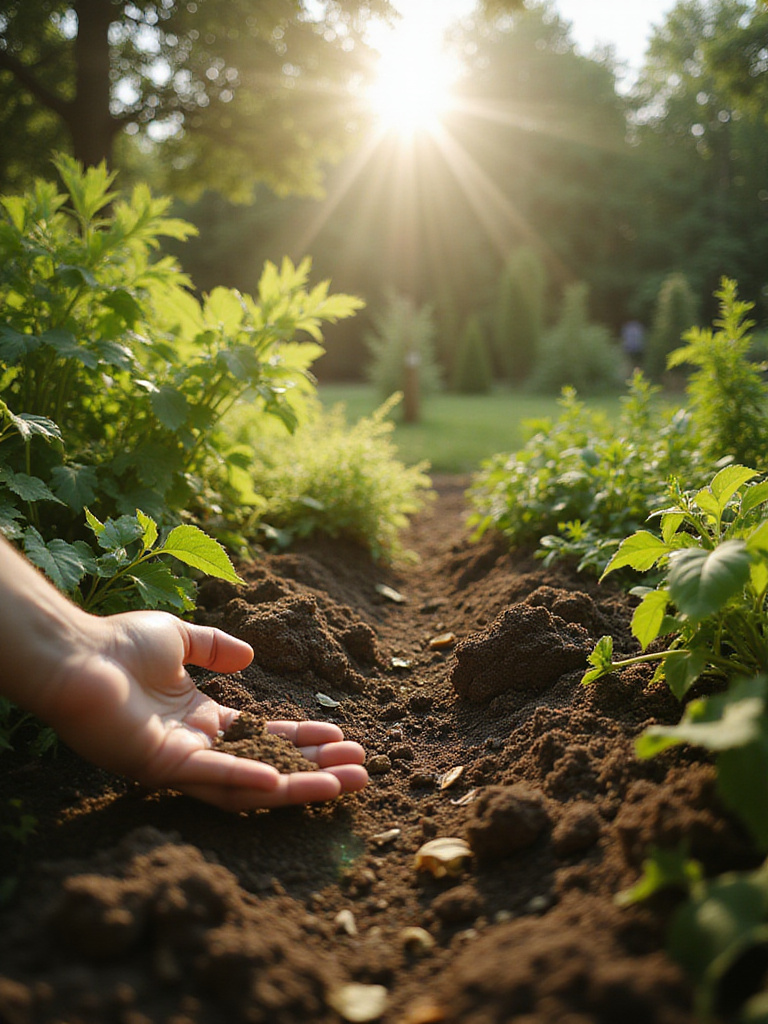
I once worked with a client who kept trying to force English roses to grow in a hot, dry patch of their yard because they saw it in a magazine. It was a constant, expensive battle against nature. I told them, “Let’s stop fighting the canvas.” We switched to sculptural, drought-tolerant grasses and dramatic yuccas that loved the sun. The space was instantly transformed from a plant hospital into a striking, minimalist sculpture garden that required almost no effort. That’s the shortcut: stop forcing your vision and start collaborating with the environment you already have.
Now that you understand the “gallery,” it’s time to decide what kind of “exhibition” you want to mount.
2. Define Your Outdoor Living Lifestyle to Tailor Your Space
People always ask me, “What art should I buy?” And I always reply, “How do you want to feel when you look at it?” The same goes for your backyard. Before you even think about a single paver or plant, ask yourself: What is the purpose of this exhibition? Is it a contemplative space for quiet mornings with coffee? A vibrant gallery for loud, laughter-filled dinner parties? Or an interactive children’s museum full of things to touch and explore? The “right” design is the one that serves the life you actually want to live.
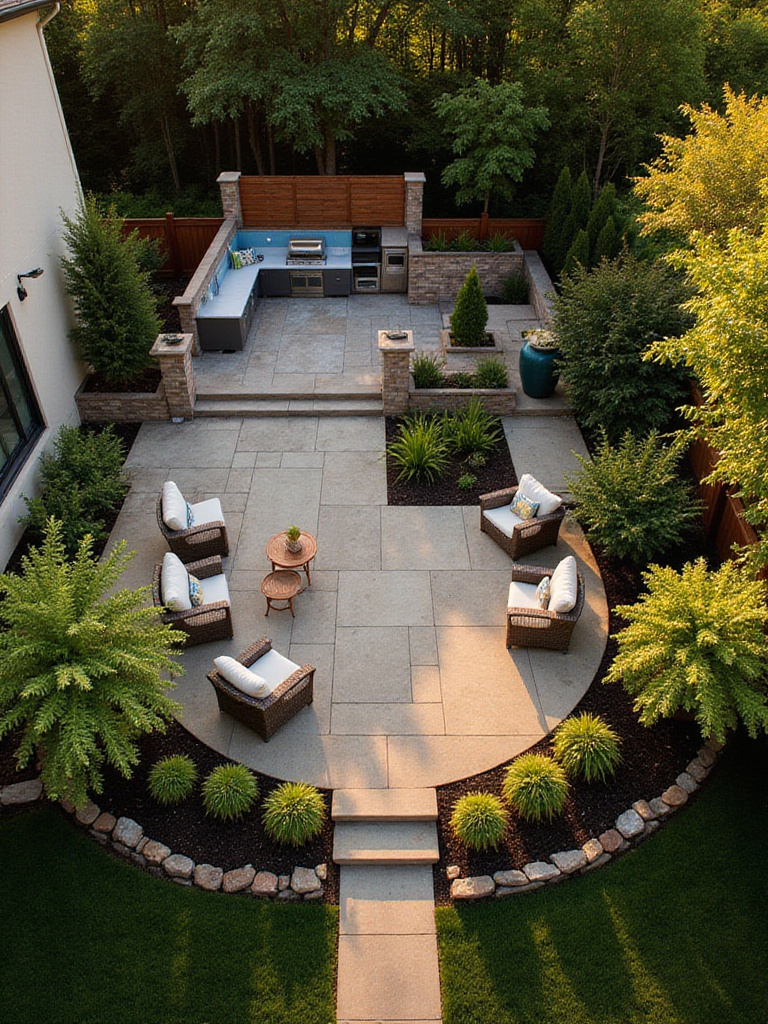
The noise you need to ignore is the endless scroll of picture-perfect backyards that have nothing to do with you. The biggest mistake is designing for a hypothetical life. I learned this the hard way with my own first tiny balcony. I filled it with delicate, fussy plants because I had a romantic notion of being a “gardener.” But I travel constantly for work. They all died. The space became a source of guilt. Now, it holds two incredibly comfortable chairs, a single stunning, low-maintenance Japanese maple in a beautiful pot, and a great outdoor light for reading. It’s an honest reflection of my life, and I use it constantly.
With your purpose defined, we have to talk about the most important creative constraint of all.
3. Establish a Realistic Budget to Guide Your Project Decisions
Let’s reframe the word “budget.” In the art world, we call it a “creative constraint.” Some of the most brilliant art in history was born from limitations—a sculptor who could only afford scrap metal, a painter with only three colors. A budget isn’t a wall; it’s a frame. It forces you to be resourceful, to make intentional choices, and to focus on what truly creates impact. A limitless budget often leads to cluttered, soulless spaces. A thoughtful budget leads to creativity.
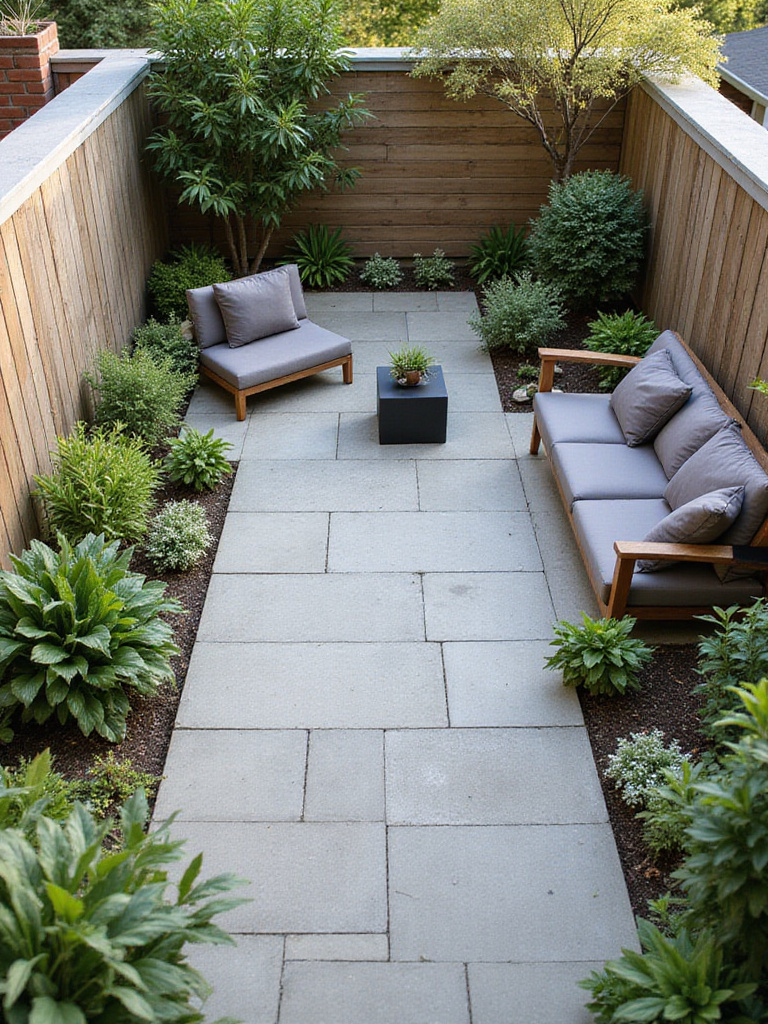
The BS everyone tells you is that a beautiful backyard has to be expensive. It’s a lie. What matters is a strong concept, not a mountain of receipts. A simple, perfectly executed gravel patio with a single magnificent tree and well-placed lighting can have more soul and impact than a million-dollar installation cluttered with every feature imaginable. Spend your money where it tells the biggest story: a knockout specimen tree, a beautifully crafted bench, or a dramatic lighting scheme. Let the other elements be quiet supporting actors.
This budget now informs the single most important document for your project.
4. Draft a Backyard Master Plan for Cohesive Design
A master plan is your curatorial statement. It’s the document that ensures every single thing you add to your backyard contributes to the same story. Without it, you’re just collecting things. A fire pit from here, a water feature from there, a random plant from the discount rack. The result is visual noise. Your master plan is the antidote to chaos. It ensures that the path you lay in year one flows beautifully toward the pergola you build in year three. It’s about playing the long game.
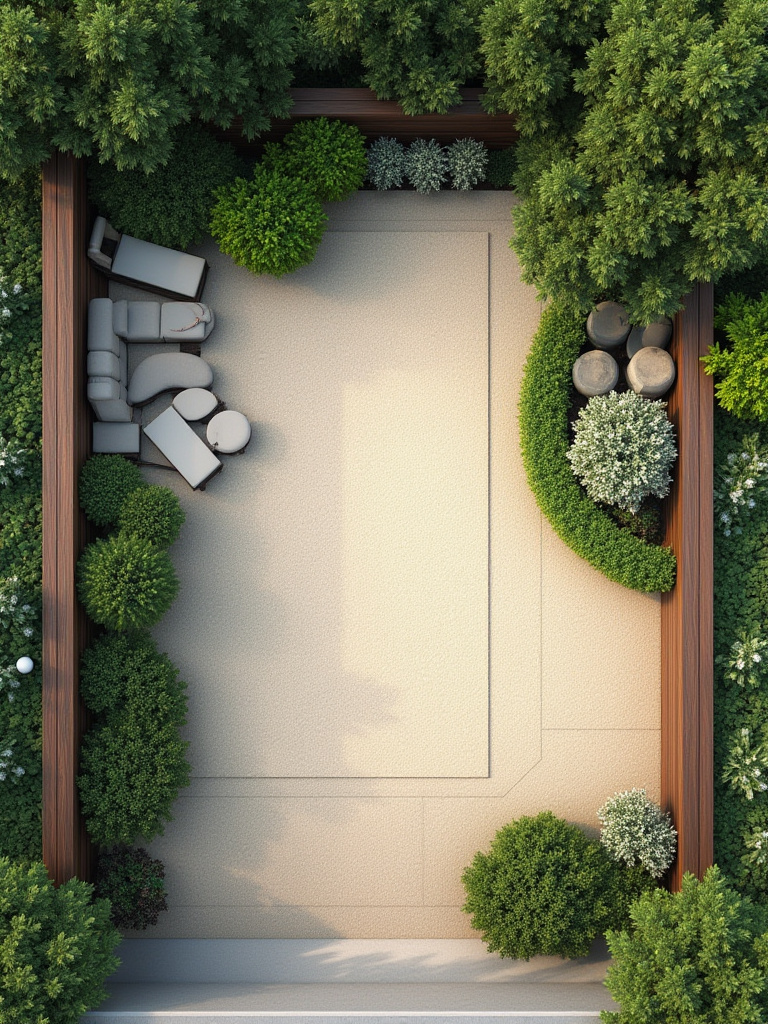
I’ve seen clients impulsively buy a huge play structure because it was on sale, only to realize it completely dominates the yard, blocks the best light, and ruins the serene, adult retreat they actually wanted. Their lack of a master plan cost them thousands and years of looking at an eyesore. Your plan doesn’t have to be a fancy architectural drawing. It can be a simple sketch on paper, but it must map out the big ideas: the zones, the flow, the focal points. It’s your promise to yourself to build a cohesive collection, not a jumble of souvenirs.
Before you finalize that plan, however, you have to deal with the gallery’s “rules.”
Laying the Groundwork: Strategic Planning & Assessment (Part 2)
We’ve dreamed a bit. Now we have to ground those dreams in reality. This part isn’t as glamorous, but it’s what separates a professional, lasting installation from an amateur one that falls apart. It’s about understanding the practical boundaries—the legal codes and the existing materials you have to work with. Think of this as preparing the gallery walls: you have to find the studs and know the weight limits before you can hang the masterpiece.
5. Research Local Regulations for Permitted Backyard Enhancements
Okay, this is the least artistic part, but it’s non-negotiable. Researching local codes and HOA rules is the equivalent of getting clearance for an installation. You can have the most breathtaking concept for a sculpture, but if it violates the building’s structural codes, it’s not happening. Ignoring permits isn’t just risky; it can force you to tear down your beautiful work. It’s a creative tragedy that is entirely avoidable.
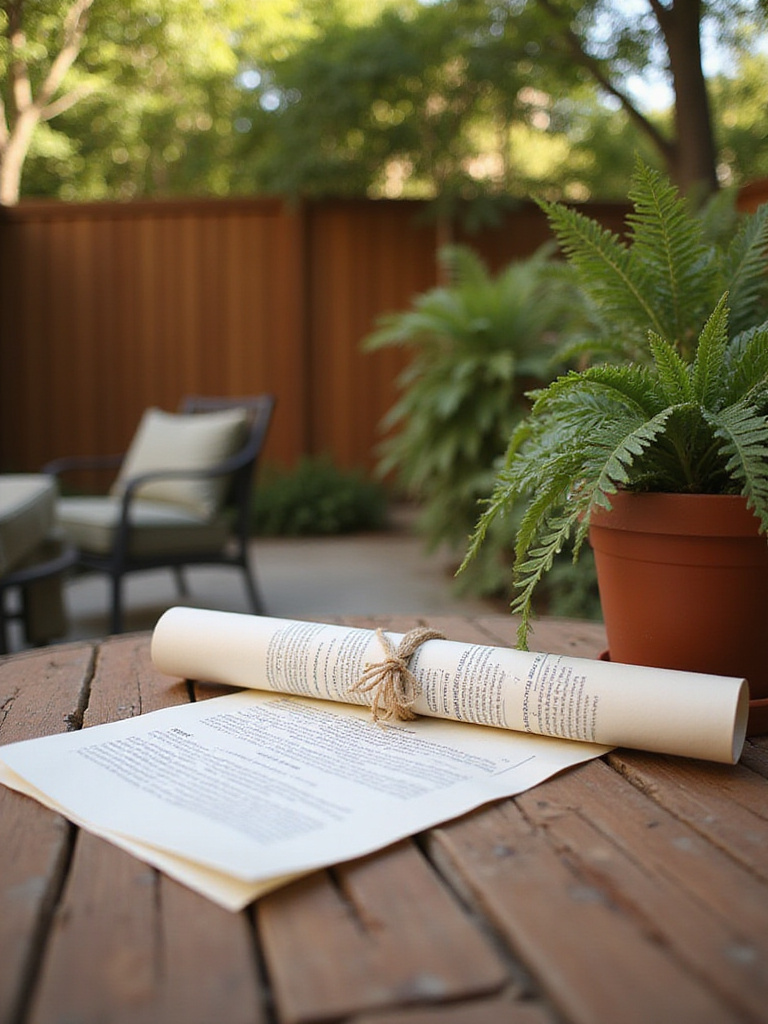
Don’t just take your contractor’s word for it. Make the call yourself. I once had a client build a stunningly modern privacy screen that was six inches too tall according to a hyper-specific local ordinance. A neighbor complained, and they had to spend a fortune modifying it. It broke their heart, and it broke the perfect proportions of the design. Do your homework. It’s ten minutes of boring that will save you ten thousand dollars of pain.
Once you know the rules, you can look at what you already have with a new set of eyes.
6. Inventory Existing Landscape Elements for Potential Repurposing
A true artist sees potential everywhere. That cracked concrete patio isn’t debris; it could be the raw material for a rustic, mosaic-style pathway. Those old bricks aren’t junk; they’re the perfect textured edging for a new garden bed. Before you spend a dime on new materials, take a curator’s inventory of what’s already on-site. This isn’t just about saving money; it’s about character. Repurposed materials bring a sense of history and soul that brand-new stuff just can’t replicate.
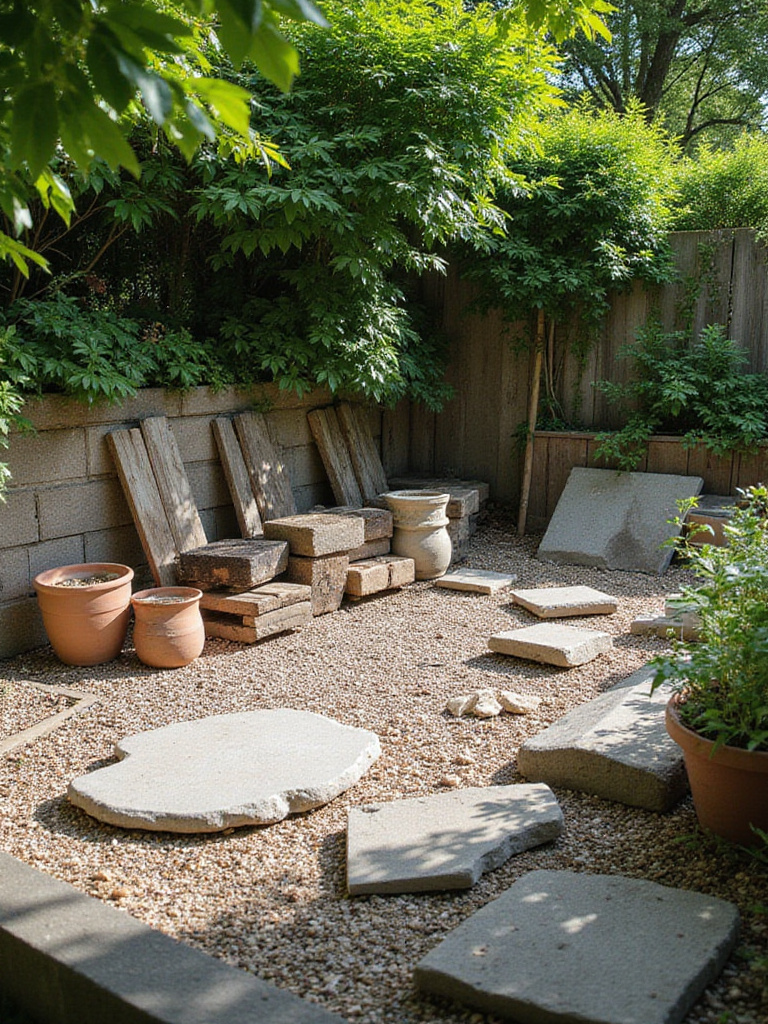
I love what Japanese art calls wabi-sabi—the beauty of imperfection and age. An old, weathered stone bench has a story. A gnarled, existing tree is an anchor for your entire design. The shortcut here is to change your perspective. Don’t ask, “What do I need to get rid of?” Ask, “How can this be transformed?” That approach is the hallmark of a truly creative eye.
With the groundwork laid, it’s time to build the structure of your outdoor gallery.
Building the Bones: Essential Design & Hardscaping (Part 1)
This is where we build the gallery itself. The “bones” of your backyard—the patios, pathways, and structures—are like the walls, floors, and rooms of a museum. They define the space, guide the visitor’s journey, and create the foundational grammar for everything that will follow. Get these right, and the “art” (the plants and decor) will have a worthy stage on which to shine.
7. Design Inviting Pathways for Seamless Movement and Flow
A pathway isn’t just for walking; it’s for directing the eye. In a gallery, we use sight lines to guide visitors from one piece to another, creating a narrative. Your backyard pathways do the same thing. A straight, rigid path says “get to the shed, quickly.” But a gently curving path creates mystery. It invites you to slow down and discover what’s around the bend. It orchestrates the experience.
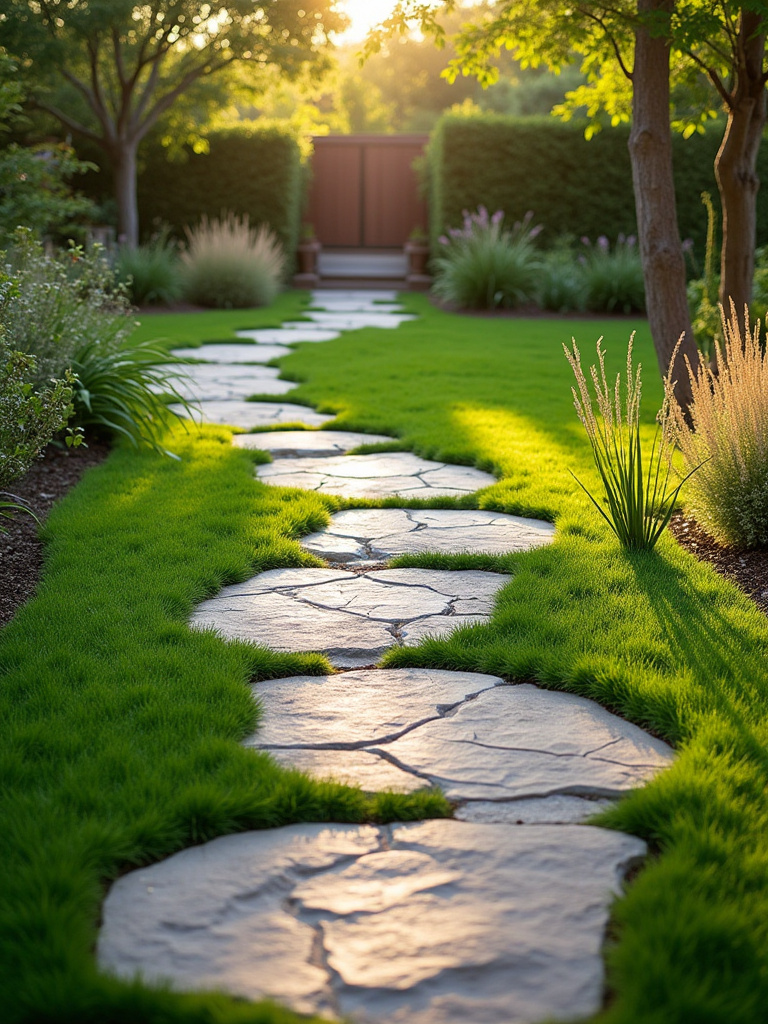
The material choice is also part of the story. Smooth pavers feel formal and modern. Irregular flagstones feel organic and rustic. Crunching gravel underfoot is a completely different sensory experience. The BS is thinking a path has to be the most direct route. It doesn’t. Its job is to control the pace and reveal the garden slowly. Think of it as the curator’s tour guide, built right into the landscape.
The pathway should lead to a destination, a primary “room” in your gallery.
8. Install Durable Patios and Decks for Defined Gathering Areas
Your patio or deck is your main exhibition hall. It’s the central space where people will gather to experience the world you’ve created. Therefore, its placement and materiality are critical. It should be an extension of your home’s architecture, not a floating island in a sea of grass. The connection between indoor and outdoor space should feel seamless, like walking from one gallery room into another.
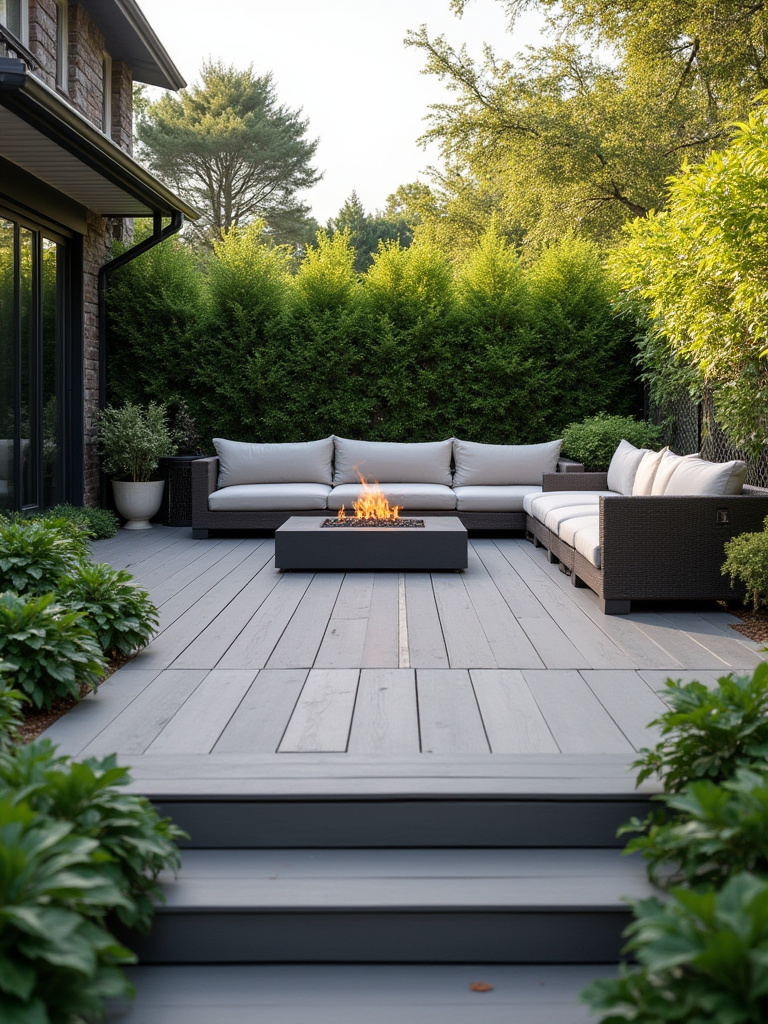
Here’s my pet peeve: people choosing a deck material based on a tiny sample at a hardware store. You are creating a massive horizontal plane of color and texture. It will be the largest single element in your composition. Take large samples home. See them in your morning light, your afternoon light, your evening light. See them wet and dry. This decision is as important as choosing the color for your living room walls. Don’t rush it.
Now let’s talk about creating a sense of intimacy within that main hall.
9. Integrate Vertical Privacy Screens or Pergolas for Seclusion
A room needs a ceiling to feel like a room. That’s what a pergola does. It defines the scale of an outdoor space, creating a sense of intimacy and enclosure without blocking the sky. It gives the feeling of a ceiling, making a large, exposed patio feel more like a comfortable, human-scaled living area. It’s an architectural trick to create a “room” outdoors. Privacy screens work similarly, acting as walls to block an unwanted view or define a boundary.
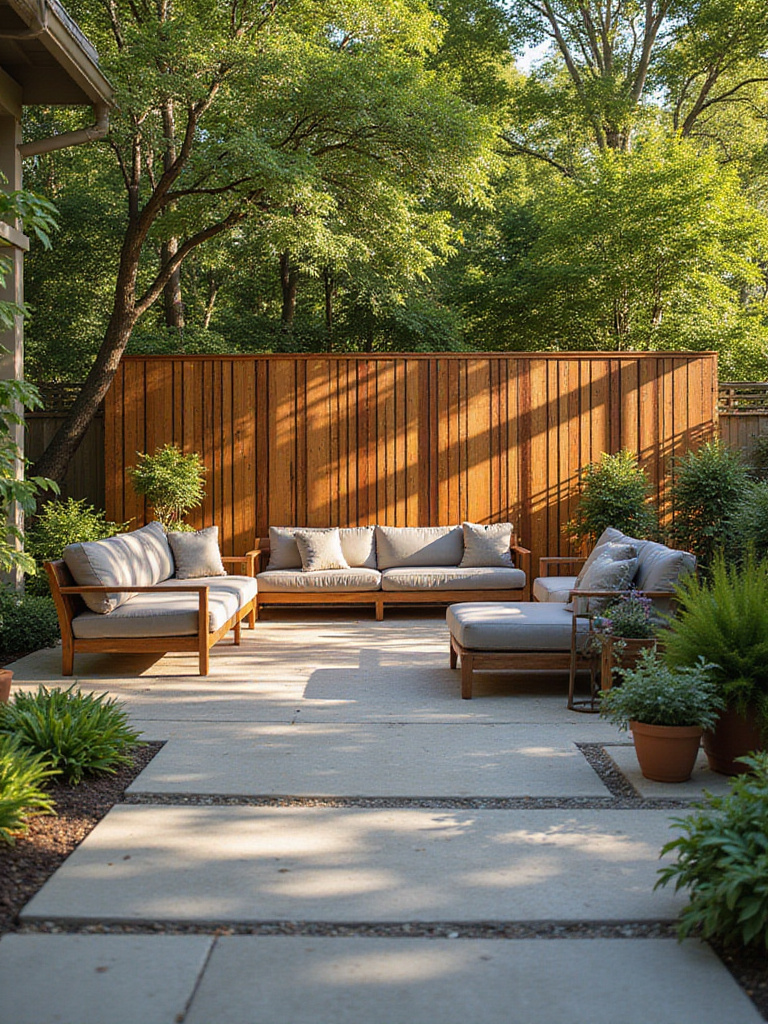
Don’t just think of these as functional objects. They are sculptural opportunities. A pergola isn’t just a grid of wood; it’s a structure that will create fascinating, moving patterns of light and shadow throughout the day. A privacy screen is a canvas. The spacing of its slats creates a rhythm. You can train a flowering vine to climb it, turning a simple wall into a piece of vertical, living art. Think of these structures not just for what they do, but for how they look and how they interact with light.
Within this room, you need the right “art” to sit on.
10. Select Resilient Outdoor Furniture for Lasting Comfort and Style
Furniture is functional sculpture. Let me say that again: functional sculpture. Too often, people buy flimsy, uncomfortable outdoor furniture that they have to replace every two years. That’s not just a waste of money; it’s a failure of vision. Your outdoor furniture should have presence, a beautiful silhouette, and a tactile quality that makes you want to touch it and use it. It is one of the most important sculptural elements in your entire design.
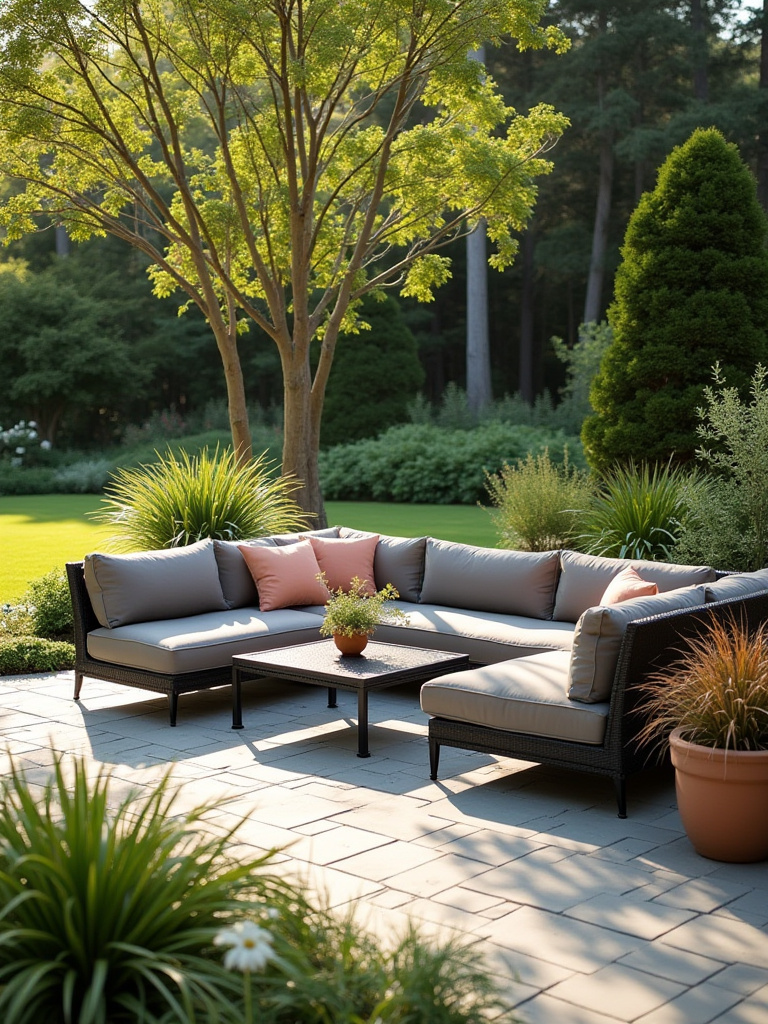
Invest in one truly incredible piece rather than a whole set of mediocrity. I once advised a client to scrap their plan for a cheap six-piece set and instead buy a single, iconic chaise lounge from a high-end designer. We placed it under their one beautiful tree. It became the undisputed focal point of the entire yard—a destination, a sculpture, a magnet for relaxation. That one piece elevated the whole space. Quality and form will always trump quantity.
Now let’s add the elements that engage the other senses.
Building the Bones: Essential Design & Hardscaping (Part 2)
We’ve defined the main spaces. Now we add the installations that bring life and energy—the elements of fire and water. These are primal forces that captivate us. In curatorial terms, these are the “interactive exhibits.” They draw people in, create a focal point, and add a layer of sensory experience that static objects can’t provide.
11. Incorporate a Calming Water Feature for Sensory Enjoyment
A water feature introduces sound and movement into your composition. A still, silent garden can feel a bit… dead. The gentle sound of trickling water is a powerful tool for masking unwanted noise from neighbors or traffic, instantly making a space feel more serene and secluded. It’s an auditory sculpture. The movement of light reflecting on the water’s surface adds a dynamic, ever-changing visual element that is utterly mesmerizing.
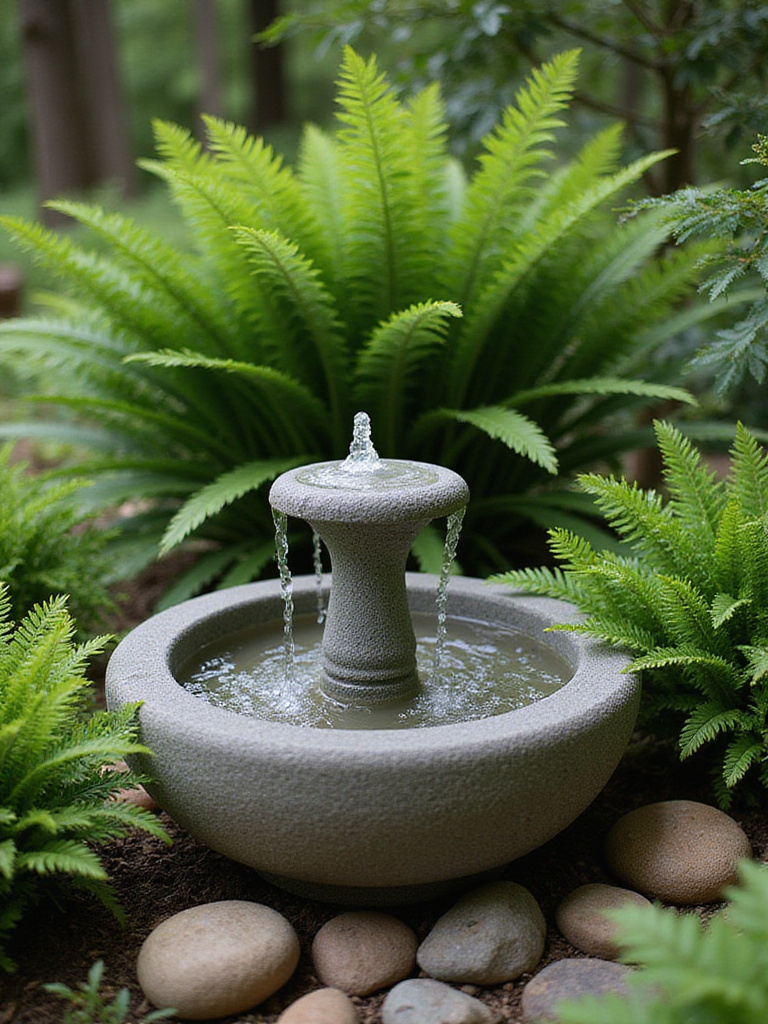
The mistake people make is thinking they need a giant, Vegas-style fountain. You don’t. A simple, self-contained ceramic urn that bubbles over can have an enormous impact in a small space. It’s about the quality of the sound, not the volume. When I was designing a small meditation garden for a client, we installed a tiny, almost hidden water feature. You heard it before you saw it, which drew you into the space and immediately quieted your mind. The sound was the art.
From water, we turn to its opposite element.
12. Strategically Place a Fire Pit or Fireplace for Evening Ambiance
Fire is the ultimate gathering point. It’s primal. It’s alive. A fire pit or fireplace isn’t just an object; it’s a piece of performance art that you get to activate. It’s the centerpiece, the anchor around which social life will orbit after the sun goes down. Its placement is therefore critical. It dictates the entire flow and feeling of your evening garden. Placing it should be a deliberate, almost ceremonial act.
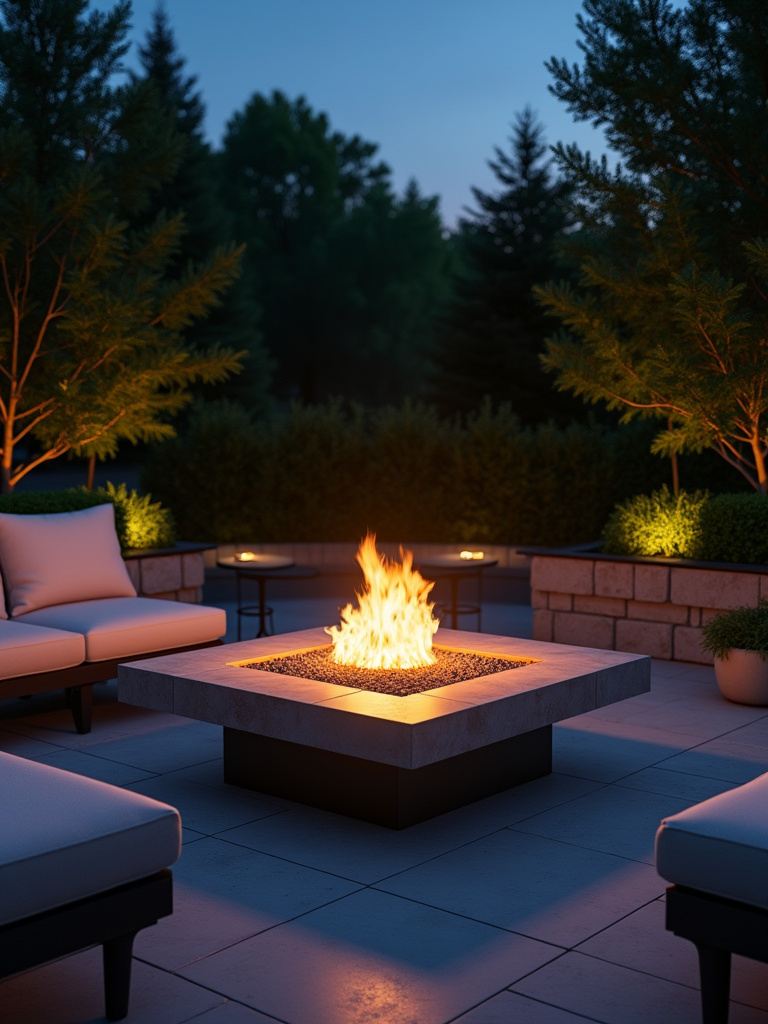
Here’s the thing everyone gets wrong: they stick it in the middle of the lawn. No. A fire feature needs to feel intentional, like it belongs to a space. It should be integrated into a patio or a dedicated gravel area, flanked by built-in seating or placed to create a specific view. I’ve noticed something weird lately—people are hiding their propane tanks like they’re shameful. Integrate it! Build a smart, beautiful little side table or enclosure for it. Make every single element part of the deliberate design.
Now that the gallery is built, it’s time to hang the art and turn on the lights.
Adding Greenery & Glow: Softscaping & Ambient Lighting (Part 1)
If hardscaping is the architecture, then softscaping—the plants—is the art collection itself. And lighting is how you display it. This is where the static structure we’ve built comes alive with color, texture, form, and emotion. A garden without thoughtful planting is just a patio. A garden without good lighting disappears at sunset. This phase transforms your space from a daytime venue into a 24-hour experience.
13. Choose Drought-Tolerant Native Plants for Sustainable Landscaping
Choosing native plants isn’t just an ecological choice; it’s an aesthetic one. Native plants belong to your landscape. They resonate with the local light, the soil, the very air. They look right. They are the artistic equivalent of using local materials in sculpture—they create a sense of place and authenticity that plants shipped from a thousand miles away can never achieve. Plus, they’re smart. They don’t demand constant attention, so you can spend your time enjoying the art, not being its servant.
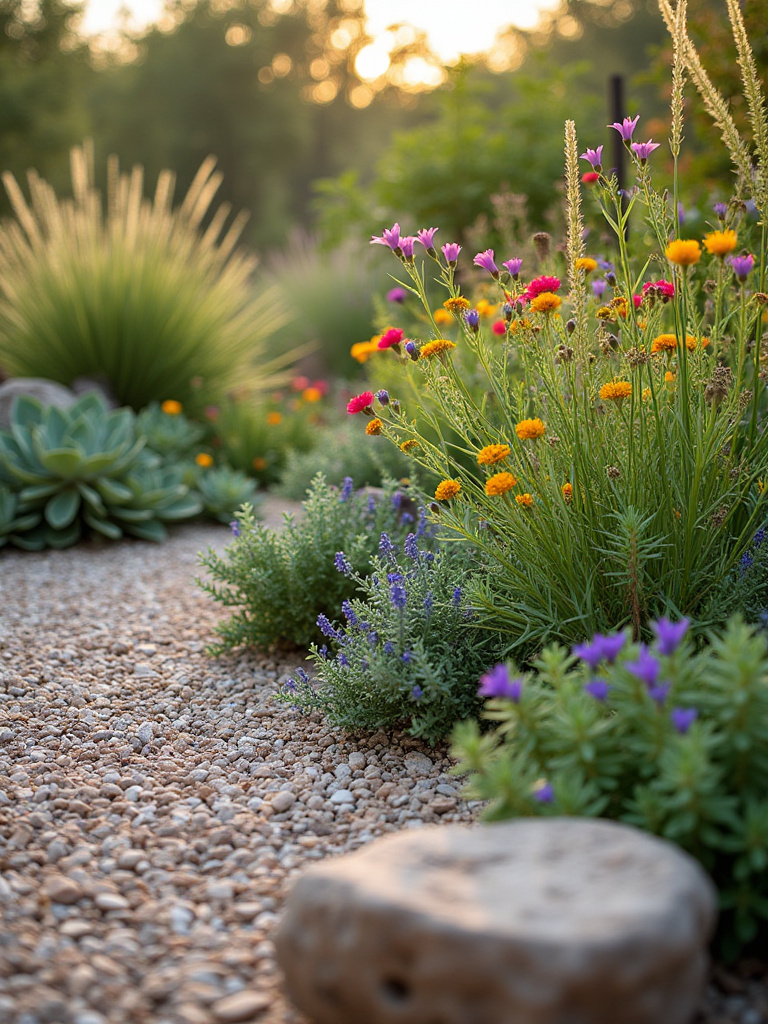
So many people think “drought-tolerant” means a garden of spiky, unfriendly cacti. That’s a total myth. Do you know how many gorgeous native perennials have soft, feathery textures and delicate flowers? Hundreds. The shortcut is to visit a local botanical garden or nature preserve. See what thrives there. Take pictures. That is your true inspiration catalog—not a national chain garden center. You’ll discover a palette of plants that tell the unique story of your region.
With your plant palette chosen, you can begin composing your “paintings.”
14. Create Thematic Garden Beds with Varied Heights and Textures
A garden bed should be composed like a great painting. You need a foreground, a middle ground, and a background. You need a variety of textures—the bold, glossy leaves of a hosta next to the fine, airy fronds of a fern. You need to play with form—the spiky verticality of an ornamental grass against the soft, mounding form of a perennial. This is composition 101. A bed of all same-sized, same-textured plants is boring. It’s a flat, one-note image.
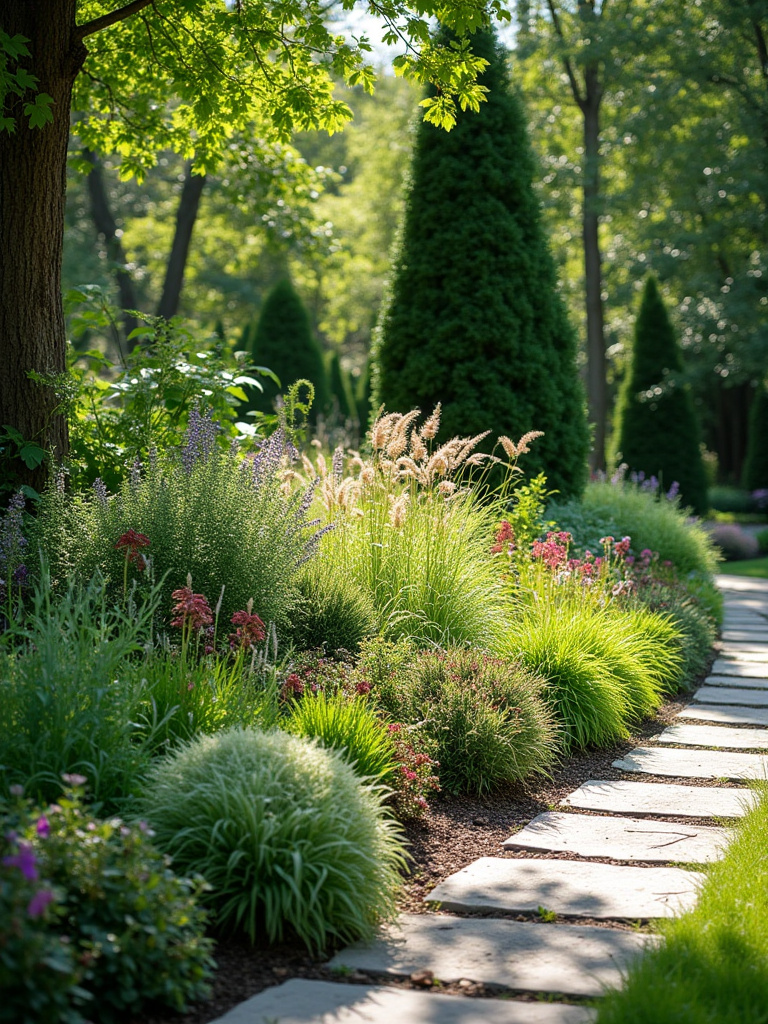
“A garden is a canvas. Don’t be afraid to use bold strokes. Contrast is your best friend. A single, dramatic plant can be the focal point that makes the entire composition sing.”
Think in layers. Tallest in the back, shortest in the front. But then, break the rules. Let one taller, airy plant (like a Verbena bonariensis) float through the front and middle layers. This creates depth and rhythm. I used to think a garden had to be perfectly neat. Then I visited Piet Oudolf’s work and realized that the beauty is in the controlled wildness. The interplay of textures and forms is where the real artistry lies.
When the sun goes down, this composition needs to be revealed in a new way.
15. Install Layered Landscape Lighting for Safety and Enchantment
Lighting is everything. You can have the most beautiful garden in the world, but if it’s lit like a prison yard with a single, harsh floodlight, the magic is gone. Good lighting is about what you don’t light as much as what you do. It’s about creating pockets of light and shadow, creating drama, and revealing texture. You are literally painting with light. This is where my curator background gets me really excited.
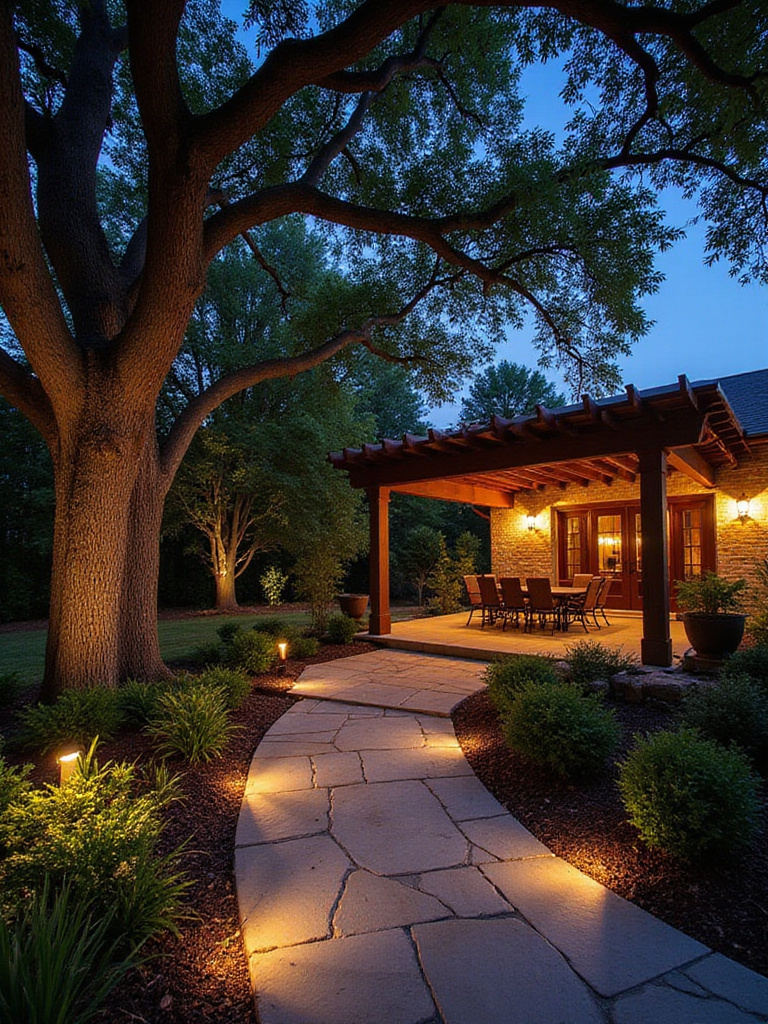
There are three main layers. “Task” lighting for paths and steps (safety first). “Accent” lighting to uplight a beautifully textured tree trunk or a piece of sculpture (this is your drama). And “ambient” lighting, a soft, general glow, perhaps from downlights mounted high in a tree to mimic moonlight. The absolute BS is that you need to light up everything. No! You need to curate the nighttime view. Pick your one “masterpiece” tree and light it perfectly. Let the rest fall into romantic shadow. That’s how you create enchantment.
And to make sure your masterpieces are cared for, you need a smart system.
16. Set Up a Smart Irrigation System for Efficient Water Management
Think of a smart irrigation system as the climate control for your living art collection. In a world-class museum, the humidity and temperature are precisely controlled to preserve the art. Your plants are living sculptures, and a smart irrigation system is the professional tool that gives them exactly what they need to thrive, without waste. It reads the weather and adjusts, so you’re not watering in the middle of a rainstorm like a traditional timer would.
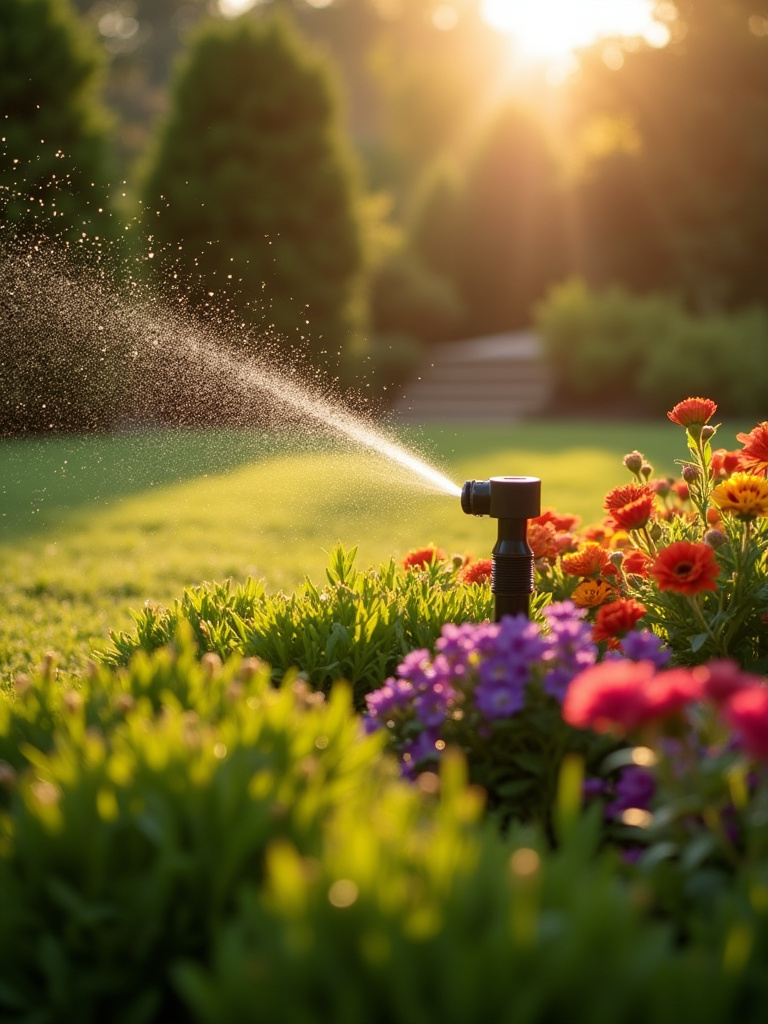
It feels like a high-tech luxury, but it’s actually a conservation tool. It’s the responsible way to be a steward of these living things. I used to be a “drag the hose around” person, thinking it was more romantic. Then I got a smart system. I learned my plants were healthier, my water bill was lower, and I had more time to actually sit in the garden and enjoy it. It’s the ultimate practical shortcut to becoming a better, more efficient caretaker of your collection.
Now, let’s explore more flexible ways to add art to the garden.
Adding Greenery & Glow: Softscaping & Ambient Lighting (Part 2)
We’ve covered the permanent collection, but every great gallery has rotating exhibits. These are the elements that provide seasonal interest and flexibility. Container gardens allow you to change the art on a whim, while an outdoor kitchen acts as a functional, social hub—a place where the art of food and community come together.
17. Utilize Container Gardens for Flexible Decor and Seasonal Color
Containers are your pop-up exhibitions. They are the easiest and most effective way to add a jolt of color, experiment with new plants, and change the entire mood of your patio from season to season. A massive, architectural pot with a single, dramatic plant is a piece of sculpture. A cluster of smaller pots with a mix of colors and textures is a living composition. They allow you to be a curator on a micro-level, constantly editing and rearranging your collection.
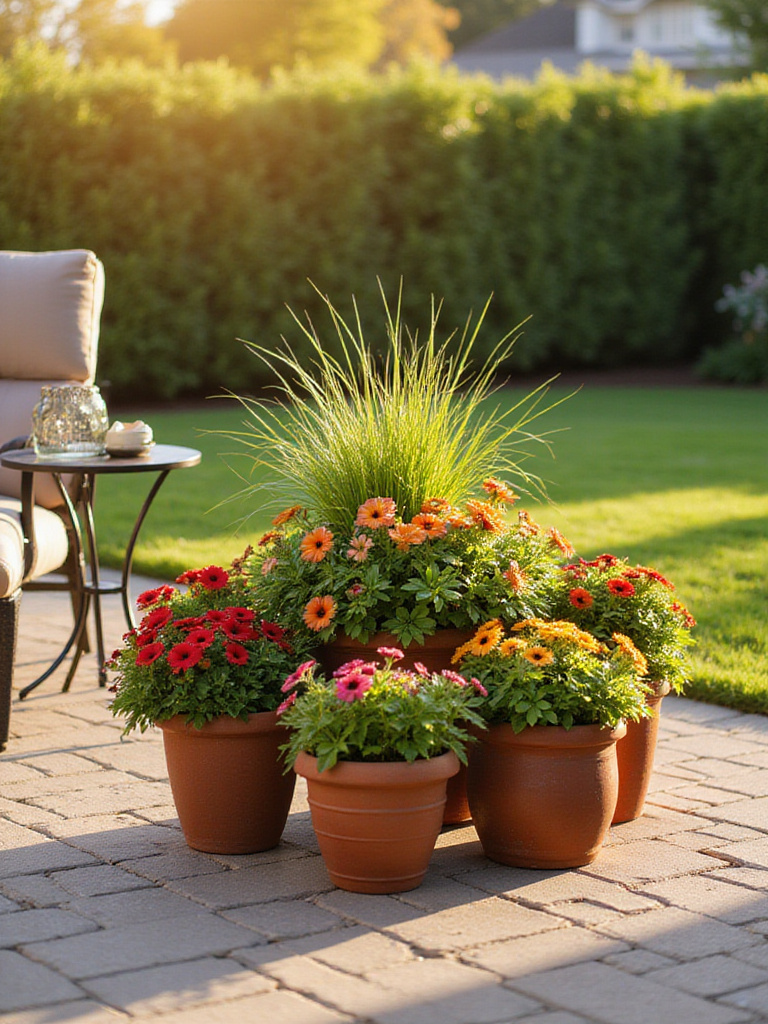
The secret I wish I’d known earlier is the “Thriller, Filler, Spiller” method. It’s a simple compositional rule that works every time. The “Thriller” is your tall, dramatic focal point in the center. The “Filler” is the mounding plants that surround it. The “Spiller” is the trailing plants that cascade over the edge of the pot. It’s a formula for creating a perfectly balanced, professional-looking arrangement, even if you’re a total beginner.
Next is the ultimate piece of functional art for your outdoor gallery.
18. Incorporate an Outdoor Kitchen or Bar for Al Fresco Dining
An outdoor kitchen isn’t just a place to grill burgers. It’s a stage. It’s a piece of social sculpture designed to bring people together. Designing it is about choreographing a social experience. Where will the cook stand? Where will guests sit and interact with them? How does the flow of food and drinks happen? It’s about creating a functional and beautiful hub that makes hosting feel effortless and elegant.
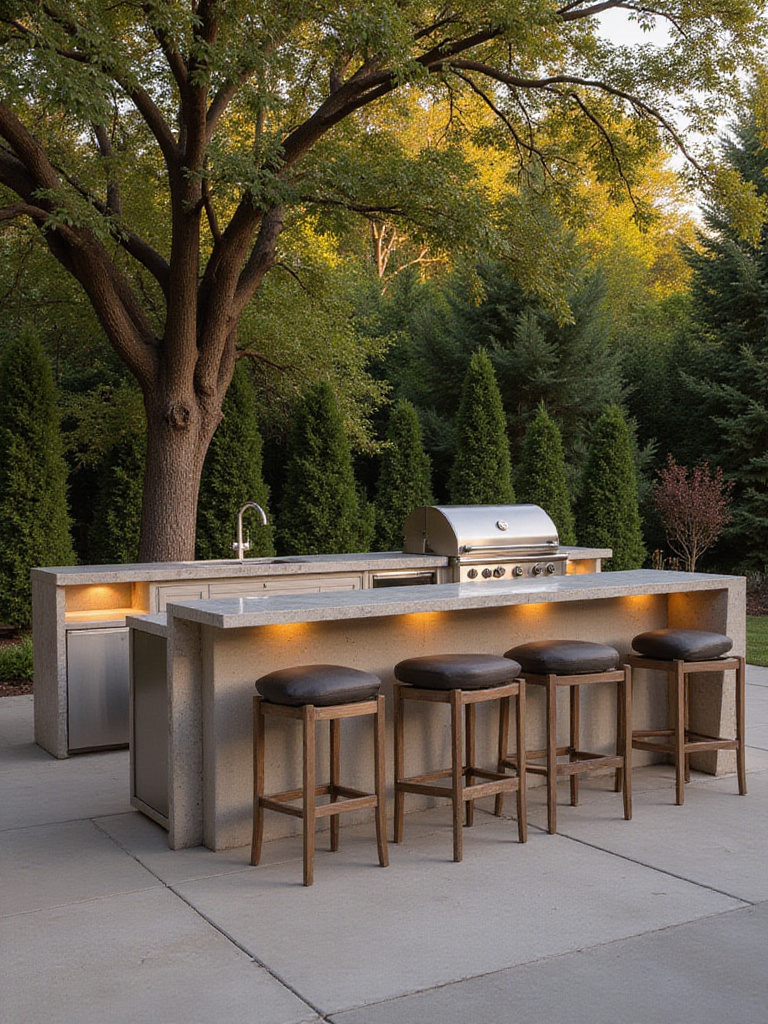
The most common mistake is cramming too many appliances into a small space and choosing materials that don’t belong outdoors. Use honest, durable materials that will age beautifully: stainless steel, natural stone, concrete. And remember negative space. You need ample counter space—the “white space” around your appliances—for prep and serving. A well-designed outdoor kitchen feels less like an appliance showcase and more like a beautifully crafted piece of custom furniture.
Now that the gallery is complete, let’s talk about how to live in it and care for it.
Personalizing & Preserving: Refinement & Long-Term Enjoyment (Part 1)
A gallery isn’t a static, finished thing. It’s a living space that needs care, attention, and evolution. This final stage is about living with your art, protecting your investment, and allowing the space to grow and change with you. This is about conservation, playful interaction, and keeping the collection fresh and exciting year after year.
19. Introduce Playful Features for Family Fun and Recreation
Play structures don’t have to be garish plastic monstrosities. Think of them as opportunities for kinetic sculpture. A beautifully crafted wooden swing set, a sleek in-ground trampoline, or even a simple bocce court can be integrated into a landscape in an elegant way. The key is to use natural materials that harmonize with the garden and to site these features thoughtfully, so they feel like part of the overall composition, not a garish afterthought.
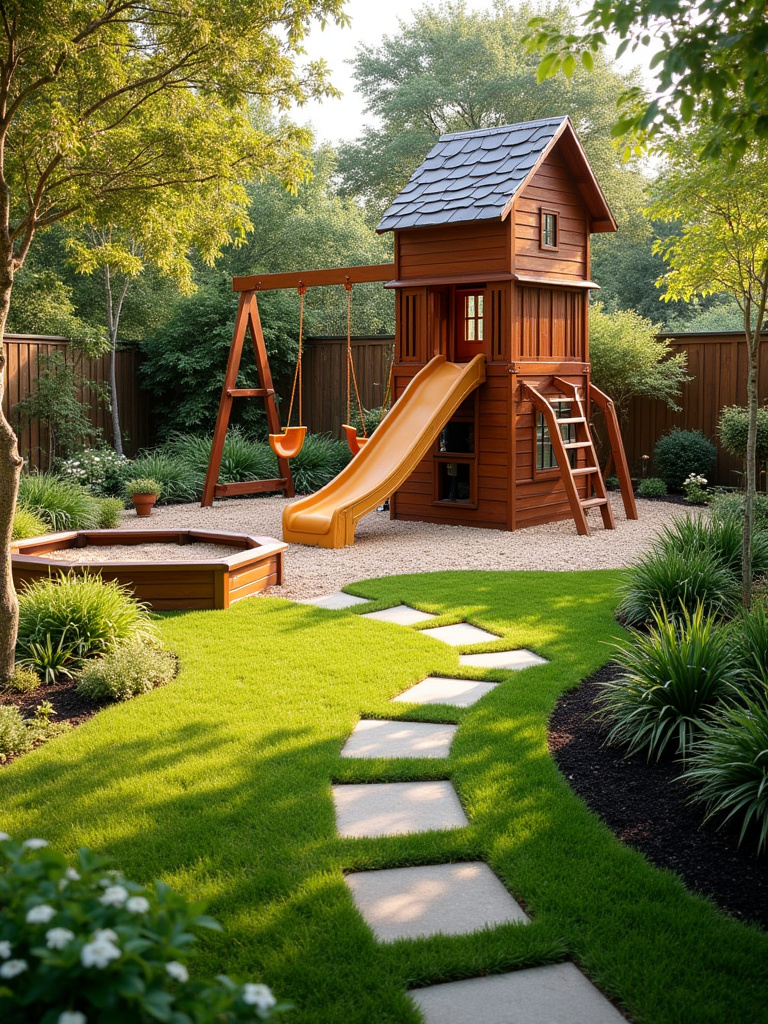
Instead of a bulky playset, consider a series of smaller, natural play elements scattered throughout the garden. A path of tree-stump stepping stones, a sandpit edged with smooth river rocks, a “secret” nook hidden behind tall grasses. This approach encourages imaginative play and discovery, turning the entire garden into an interactive exhibition for children, rather than confining “fun” to one brightly colored corner. It’s a more artful, integrated way to think about family recreation.
Just like with children, the plants themselves require protection.
20. Boost Natural Privacy with Strategic Tree and Shrub Placement
A fence is a wall. A hedge is a living sculpture that breathes. Using layered trees and shrubs to create privacy is one of the most elegant solutions in landscape design. It’s about creating a “soft” wall that absorbs sound, provides a beautiful textured backdrop, and changes with the seasons. It creates a sense of being enveloped by nature, rather than being boxed in by construction.
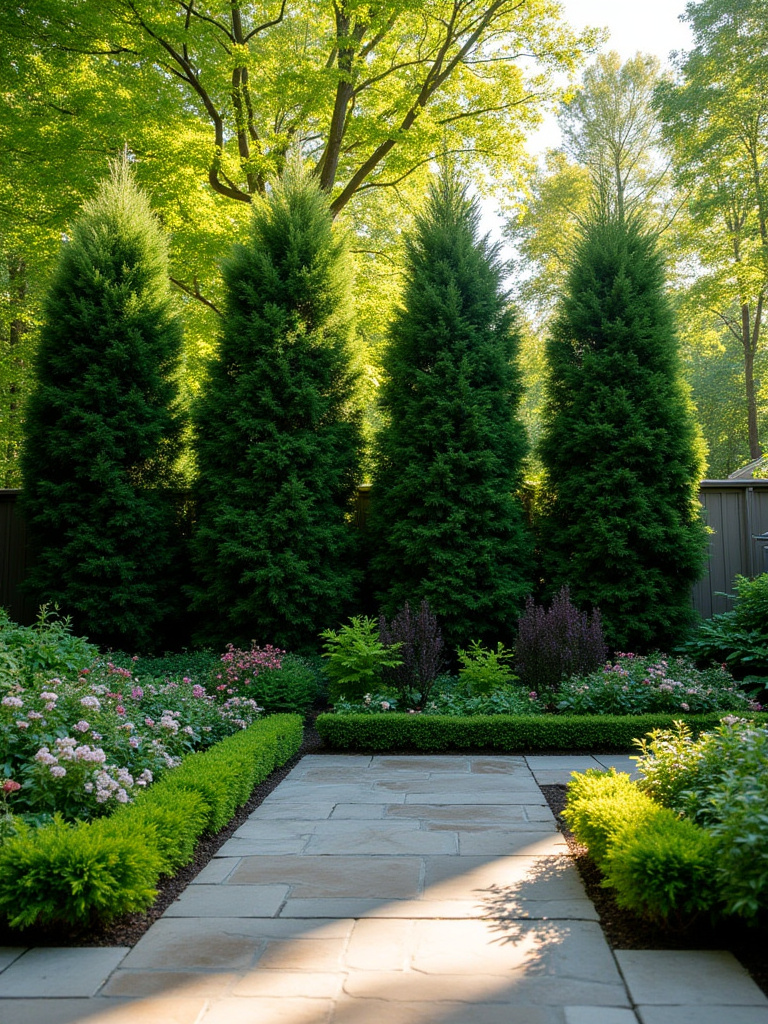
Everyone says, “Plant a row of arborvitae.” But here’s what actually happens: a rigid, uniform wall of green can look monotonous, and if one tree dies, you have a giant, ugly gap. A much more sophisticated approach is to plant a layered, mixed border. Use a backbone of taller evergreens, then layer in deciduous shrubs with interesting branch structures, and finish with lower perennials. This creates a rich, resilient tapestry that has visual interest all year round.
This living tapestry, and your hardscapes, require a curator’s care.
21. Implement a Regular Maintenance Schedule for Hardscaping Longevity
Conservation is a vital part of any curator’s job. You can’t just hang the art and walk away. Your hardscaping—the beautiful stone patio and walkways—is the same. It’s an investment that needs to be protected. A simple, regular maintenance schedule for cleaning, weeding, and sealing is the unglamorous work that keeps your gallery looking pristine. It prevents small problems from becoming huge, costly repairs.
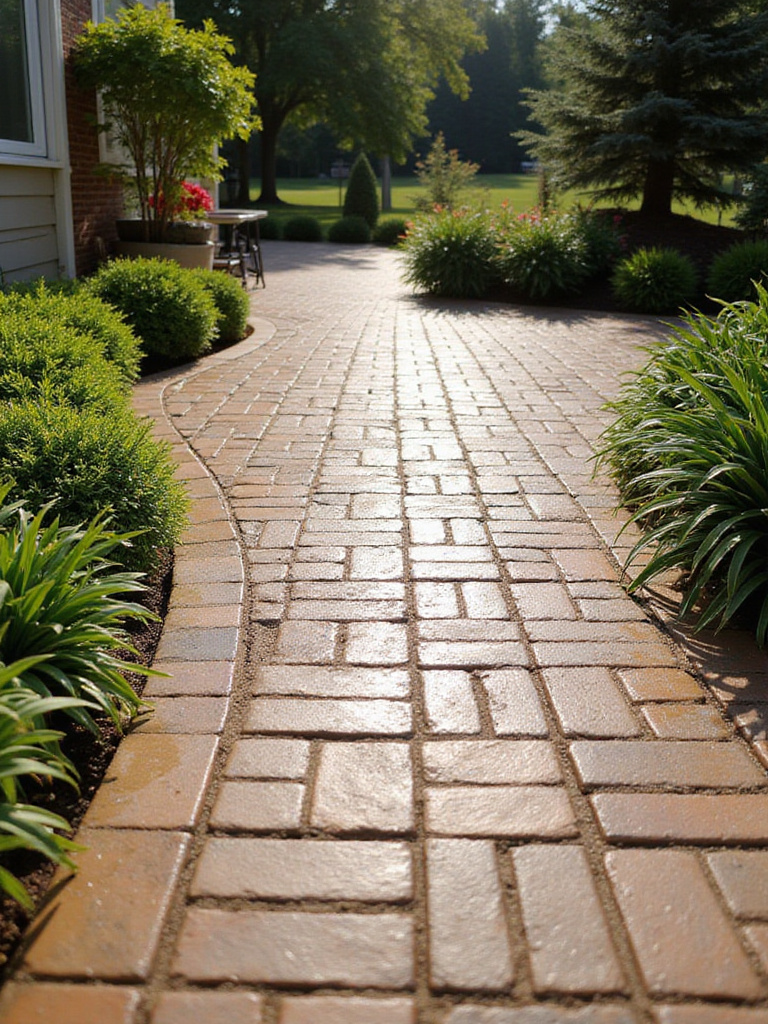
This isn’t about constant, back-breaking labor. It’s about small, consistent actions. A quick sweep once a week. Pulling a few weeds while you sip your morning coffee. The shortcut is to seal your stonework every few years. Sealing is like putting a protective varnish on a painting. It repels water, prevents stains, and makes the colors of the stone look richer and deeper. It’s the single best thing you can do to preserve the beauty and longevity of your investment.
Preservation also applies to the more transient elements.
22. Refresh Your Outdoor Decor Seasonally for Evolving Charm
Your outdoor decor—the cushions, lanterns, and tablecloths—are your rotating exhibition. This is your chance to play, to experiment with color and pattern without any long-term commitment. Keeping the same faded cushions out all year is like a gallery leaving the same show up for a decade. It gets tired. Swapping out your decor seasonally keeps the space feeling alive, fresh, and intentional.
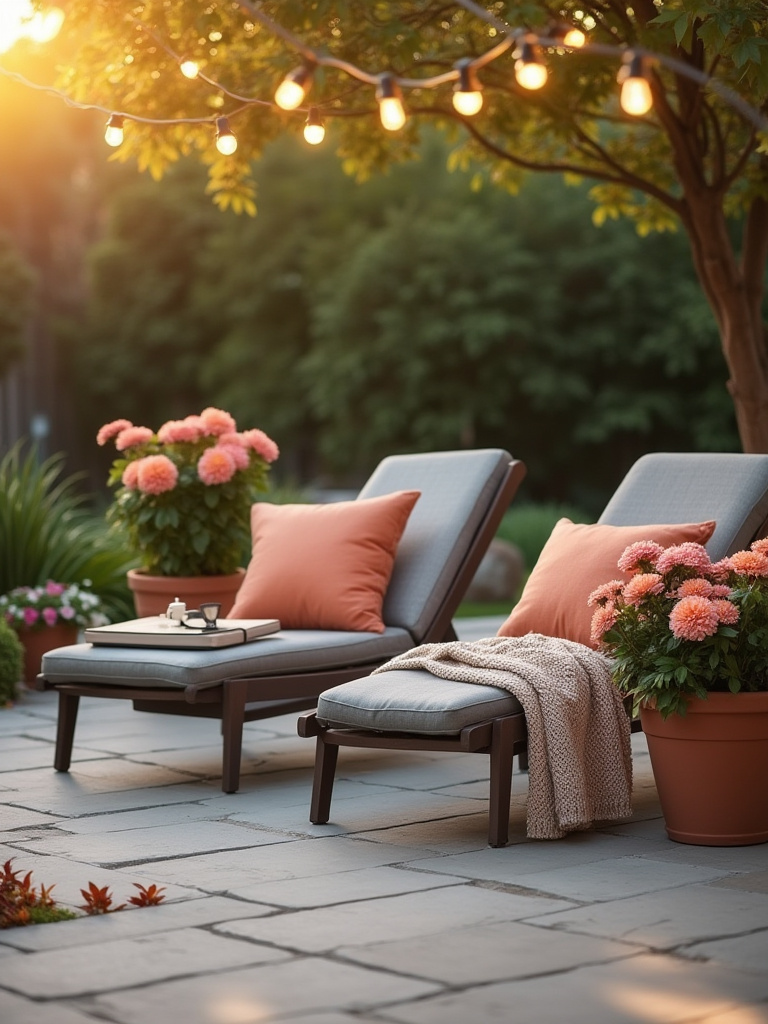
Don’t just think in terms of holidays. Think in terms of seasons. For summer, maybe it’s bright, crisp blues and whites. For fall, swap in rich oranges, deep reds, and cozy wool throws. It’s a simple, low-cost way to completely change the energy of your space. I store my off-season cushions and decor in sealed bins. The twice-a-year swap feels like a ritual, a conscious act of welcoming the new season into my home and garden.
Finally, let’s bring our gallery into the 21st century.
Personalizing & Preserving: Refinement & Long-Term Enjoyment (Part 2)
The final touch in a modern exhibition is often technology. Not for its own sake, but used thoughtfully to enhance the visitor experience, to control the environment, and to make the entire space more intuitive and effortless. This is where smart home tech comes in—not as a gimmick, but as the invisible “docent” that runs your backyard gallery flawlessly.
23. Embrace Smart Home Technology for Enhanced Backyard Control
Smart home technology is your behind-the-scenes gallery assistant. It’s the tool that allows you to be the artistic director without having to flip every single switch manually. Imagine creating a “Sunset” scene that, with one tap on your phone, dims your landscape lights to the perfect level, turns on the bubbling water feature, and starts a relaxing playlist on your outdoor speakers. That’s not tech for tech’s sake; that’s using technology to effortlessly create a specific mood.
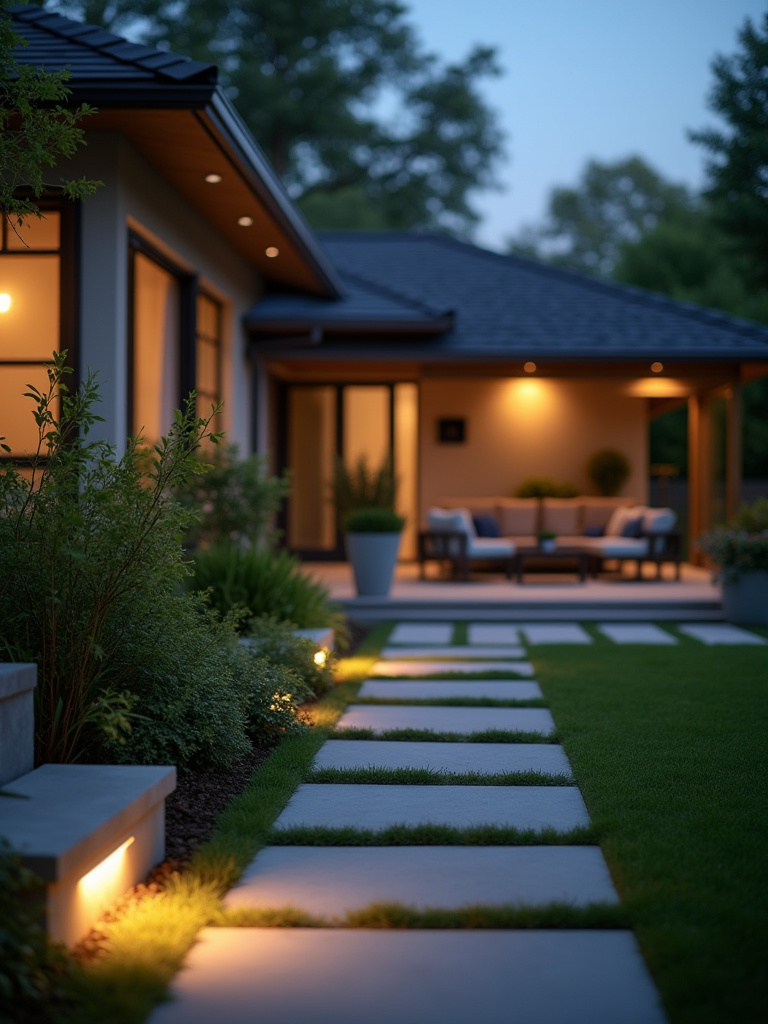
The key is to integrate it seamlessly, so the tech disappears and you’re just left with the experience. Outdoor smart plugs can control string lights. A smart controller for your landscape lighting lets you fine-tune the brightness of each zone from your couch. This is the ultimate shortcut to living in a perfectly curated environment. It lets you focus on the feeling, the art, and the people, while the technology handles the logistics in the background. It is the final layer of effortless sophistication.
Conclusion
We’ve walked through the entire process, from finding the soul of your space to placing the final, living sculptures within it. The single most important idea to take away is this: your backyard is a form of self-expression. It is a deeply personal gallery that should tell your story, not replicate a photo from a magazine.
Stop thinking in terms of “rules” and start thinking in terms of composition, emotion, and light. Trust your eye. If a particular plant or object brings you joy, find a way to make it the star of the show. Edit ruthlessly. Not every idea deserves a place in the final exhibition. And most importantly, enjoy the process. Curating your outdoor space is a slow, rewarding art form that will evolve with you over time. Now, go create your masterpiece.
